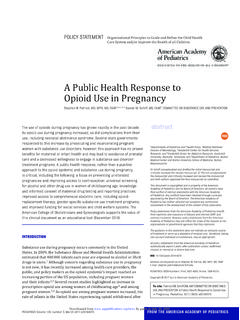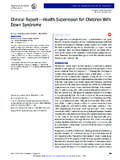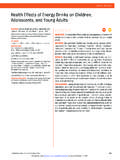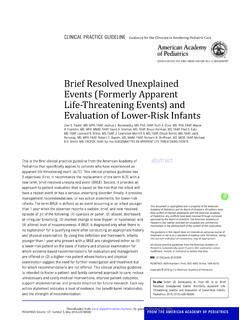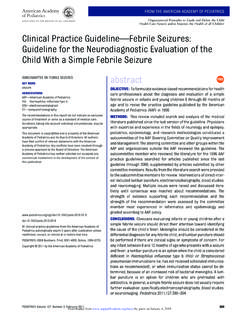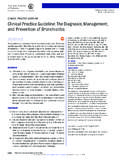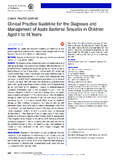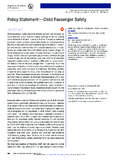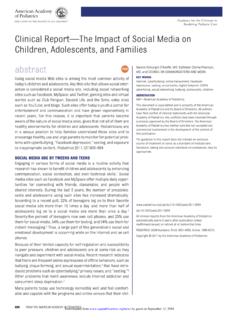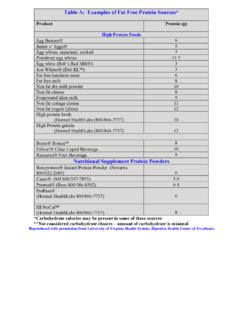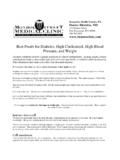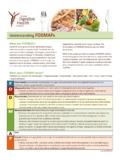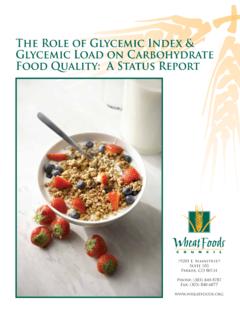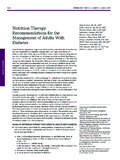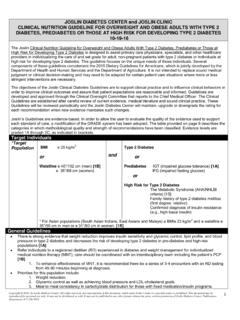Transcription of Management of Type 1 Diabetes With a Very Low …
1 ARTICLEM anagement of Type 1 Diabetes With a Very Low carbohydrate DietBelinda S. Lennerz, MD, PhD, a, b Anna Barton, MD, c Richard K. Bernstein, MD, d R. David Dikeman, PhD, e Carrie Diulus, MD, f Sarah Hallberg, DO, g Erinn T. Rhodes, MD, MPH, a Cara B. Ebbeling, PhD, a, b Eric C. Westman, MD, h William S. Yancy Jr, MD, h David S. Ludwig, MD, PhDa, bOBJECTIVES: To evaluate glycemic control among children and adults with type 1 Diabetes mellitus (T1DM) who consume a very low carbohydrate diet (VLCD).METHODS: We conducted an online survey of an international social media group for people with T1DM who follow a VLCD. Respondents included adults and parents of children with T1DM. We assessed current hemoglobin A1c (HbA1c) (primary measure), change in HbA1c after the self-reported beginning of the VLCD, total daily insulin dose, and adverse events.
2 We obtained confirmatory data from Diabetes care providers and medical : Of 316 respondents, 131 (42%) were parents of children with T1DM, and 57% were of female sex. Suggestive evidence of T1DM (based on a 3-tier scoring system in which researchers took into consideration age and weight at diagnosis, pancreatic autoimmunity, insulin requirement, and clinical presentation) was obtained for 273 (86%) respondents. The mean age at diagnosis was 16 14 years, the duration of Diabetes was 11 13 years, and the time following a VLCD was years. Participants had a mean daily carbohydrate intake of 36 15 g. Reported mean HbA1c was Only 7 (2%) respondents reported Diabetes -related hospitalizations in the past year, including 4 (1%) for ketoacidosis and 2 (1%) for : Exceptional glycemic control of T1DM with low rates of adverse events was reported by a community of children and adults who consume a VLCD.
3 The generalizability of these findings requires further studies, including high-quality randomized controlled of Endocrinology, and bNew Balance Foundation Obesity Prevention Center, Boston Children s Hospital and Harvard Medical School, Harvard University, Boston, Massachusetts; cRichmond Diabetes and Endocrinology, Bon Secours Medical Group, Richmond, Virginia; dNew York Diabetes Center, Mamaroneck, New York; eLockheed Martin, Honolulu, Hawaii; fCrystal Clinic Orthopaedic Center, Akron, Ohio; gVirta Health and Indiana University Health, School of Medicine, Indiana University, Indianapolis, Indiana; and hDuke University Medical Center, Durham, North CarolinaDr Lennerz conceptualized and designed the study, created the data collection instruments, collected the data, reviewed the medical records, conducted the statistical analyses, drafted the initial manuscript, and maintained full control over the database and all statistical analysis; Drs Barton and Diulus conceptualized the study, participated in the design of the data collection instruments, and revised the manuscript; Drs Bernstein, Dikeman, Hallberg, Rhodes, and Ebbeling participated in the design of the data collection instruments and revised the manuscript; Drs Westman and Yancy participated in the scientific design and revised the manuscript.
4 Dr Ludwig conceptualized and designed the study, drafted the initial manuscript, and maintained full control over the database and all statistical analysis; and all authors approved the final manuscript as submitted and agree to be accountable for all aspects of the : https:// doi. org/ 10. 1542/ peds. 2017- 3349 Accepted for publication Mar 8, 2018 PEDIATRICS Volume 141, number 6, June 2018:e20173349 WHAT S KNOWN ON THIS SUBJECT: Despite pharmacological and technological advances, optimal glycemic control of type 1 Diabetes remains elusive, putting millions of people worldwide at increased risk of micro- and macrovascular complications. One conceptually promising but poorly studied approach is dietary carbohydrate THIS STUDY ADDS: Exceptional glycemic control of type 1 Diabetes without high rates of acute complications may be achievable among children and adults with a very low carbohydrate diet.
5 However, the generalizability of these findings and long-term safety of carbohydrate restriction remain cite: Lennerz BS, Barton A, Bernstein RK, et al. Management of Type 1 Diabetes With a Very Low carbohydrate Diet. Pediatrics. 2018;141(6):e20173349 by guest on August 28, from Before the discovery of insulin, the lives of children with type 1 Diabetes mellitus (T1DM) were extended, sometimes for years, by severe carbohydrate After the advent of insulin treatment, the recommended carbohydrate intake was increased without clinical trial proof of superiority. By the 1980s, a low-fat diet containing up to 60% of energy from carbohydrates became the standard of More recently, the American Diabetes Association (ADA) has emphasized the individualization of diet rather than focusing on major medical and technological advances, the Management of T1DM remains suboptimal.
6 With an average overall hemoglobin A1c (HbA1c) of , only 20% of children and 30% of adults achieve the glycemic targets of HbA1c <7% for adults and < for children as set forth by the ADA to reduce long-term The greatest challenge in this regard involves difficulty controlling postprandial glycemia, which is a major determinant of Even with modern insulin analogs and technical advances, a mismatch between carbohydrate absorption and insulin action typically exists after meals. Beyond a point, measures to lower postprandial hyperglycemia inevitably increase risk for hypoglycemia, with potentially life-threatening 9 The source and amount of carbohydrates consumed affect postprandial hyperglycemia and glycemic variability more than any other dietary factor, 3, 10 12 providing a conceptual basis for interest in carbohydrate -modified diets for T1DM.
7 Regarding carbohydrate source, a diet with a low versus high glycemic index can be used to reduce HbA1c moderately (by ).13 Case series and pilot studies reveal more substantial improvements in HbA1c and other benefits (less hypoglycemia and reduced glycemic variability) with a very low carbohydrate diet (VLCD).14 21 Although varying to some degree among studies, a VLCD is typically defined as 20 to 50 g per day of carbohydrates or 5% to 10% carbohydrates as a proportion of 24 In T1DM, small sample sizes and methodological issues limit the significance of VLCD benefits, and little is known about prevalence, practice, and sustainability. In the absence of larger studies in pragmatic settings, a VLCD is generally discouraged out of concern for potential diabetic ketoacidosis (DKA), hypoglycemia, dyslipidemia, nutrient deficiency, growth failure in children, and , 26 Our aim in this study was to characterize glycemic control and acute adverse events among children and adults who have adopted this approach for the long-term self- Management of an online survey, we collected primary data from respondents and confirmatory medical information from a secondary survey of health care providers or a review of medical records.
8 Our goals were to (1) establish that adult respondents and children for whom an adult respondent completed the survey (both henceforth referred to as participants) were formally and accurately diagnosed with T1DM, (2) characterize glycemic control (ie, HbA1c, total daily insulin dose, average blood glucose concentrations and SD as measured by a continuous glucose monitor [CGM] or glucose meter), (3) determine adverse event rates (eg, DKA, hypoglycemia, Diabetes -related hospitalizations and emergency department visits), (4) assess anthropometrics (eg, weight, height, and BMI) and metabolic health parameters (eg, serum lipids), (5) compare longitudinal changes in glycemic control (pre- to post-VLCD), and (6) characterize participants satisfaction with their Diabetes Management and relationship with the health care system.
9 The study was approved by the Boston Children s Hospital Institutional Review Board and is registered at www. clinicaltrials. gov (identifier NCT02839174). Electronic consent was obtained from the and EnrollmentA volunteer sample was recruited from TypeOneGrit, an online Facebook community for people with T1DM who follow a VLCD and Diabetes Management method as recommended in the book Dr Bernstein s Diabetes , 27 This method comprises a VLCD with weight-based carbohydrate prescription of up to 30 g per day derived from fibrous vegetables and nuts with a low glycemic index. High-protein foods with associated fat are substituted for carbohydrates and adjusted on the basis of outcomes, including glycemic control and weight. Participants adhere to a structured meal plan and adjust bolus insulin empirically according to postprandial glycemia.
10 Basal insulin is adjusted according to fasting glycemia. The group was established in April 2014, with 1900 members at the time of the used an eligibility survey of community members between September 2016 and November 2016. Members aged 18 years were eligible if they or a child in their care satisfied these 3 self-reported criteria: having T1DM, receiving insulin therapy, and consuming a carbohydrate -restricted diet for at least 3 months. Women who were pregnant or breastfeeding were excluded. Of 493 eligibility survey responses, 414 (84%) individuals were eligible to participate and 316 (76%) provided sufficient information to be included in the study (Fig 1). With respondent LENNERZ et al2 by guest on August 28, from permission, we contacted 182 providers; 97 (53%) completed the full or short provider survey.
